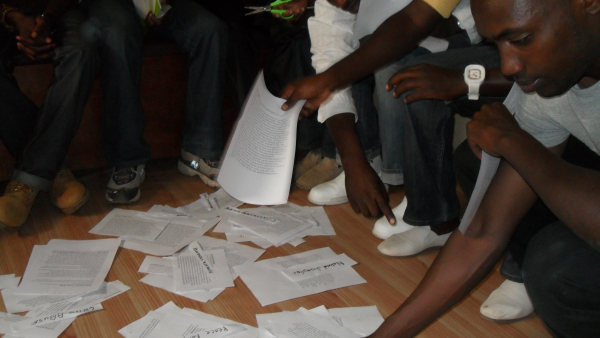How do we make storytelling a more regular part of our work?

Photo Credit: GlobalGiving
Take small steps and have fun.
Gathering stories may feel daunting, especially if you feel like you need to create a full-fledged storytelling program. Instead, start out with a small experiment in storytelling. Or try making each individual story shorter—a one-minute video instead of three minutes, a photo with a paragraph of narrative instead of a pages-long testimonial. Focus on the craft of telling, editing, or performing stories and the great feeling that comes with creating something. Once you get in the swing of things, you’ll find storytelling easier—and not only that, you may find that it makes your work more efficient and even fun.
Stories rarely emerge fully formed in the first telling, but “good enough” stories can usually meet your goals. Is the story going in an expensive annual report with a long shelf life, or do you need just an anecdote to humanize a speech you’re giving? Or perhaps you need just short narratives to get a sense of where your community or colleagues are on an issue? The goals of your story work should align with the resources you can dedicate to it.
Hire someone from the community to work with you.
“[Progressives should] build a politics that embraces the dreams of people and fashion spectacles which give these fantasies form—a politics that understands desire and speaks to the irrational; a politics that employs symbols and associations; a politics that tells good stories.” —Stephen Duncombe, Dream: Re-imagining Progressive Politics in an Age of Fantasy
You may be at some distance from the community you want to gather stories from or otherwise feel unqualified to tell their stories. Consider bringing on a volunteer, intern, or staff member to do it. You might follow the lead of GlobalGiving, which in 2010 launched its Storytelling Project, hiring and training “scribes” to gather stories in selected countries where it operates. Or consider the Walter and Elise Haas, Jr. Fund, which hired an oral-history organization to collect “First Person Stories” to illustrate the human drama behind the issues it works on.
Set guidelines for your story collection.
Whether you’re collecting stories from your staff, board, clients, donors, or visitors to your website, tell them precisely what you want and other pertinent information. Creating a short set of guidelines or offering a couple samples of what you’re looking for will yield better content and prevent bruised egos. (That’s what the group Northern California Grantmakers did in its Philanthropic Storytelling Toolkit.) Questions to address include:
- What story do you want them to tell? Is it about a specific event, theme, or experience?
- What is the suggested length?
- Are there any prohibitions, such as on hate speech or other language?
- Are photos and videos needed, and what are the technical specifications?
- What additional information (name, email address, phone) is needed?
- Where and how will the story be used? Will the storyteller have input?
- Will the person be named or remain anonymous?
- Will the story be used as is, or might it be edited for length or clarity?
- Will the story definitely be used, or is there a chance it will not be used?
- Does the storyteller need to give permission, such as on a release form?
Be systematic in your story gathering.
Use a story-gathering method that requires the least finagling. You can have people submit text stories via Google Docs, or videos on YouTube, or photo stories on Facebook, but make sure users have clear instructions about how to share stories and, as above, what kinds of stories to share. Email or phone are fine collection tools as well, but the more systematic you are the easier the project will be to complete.
Be clear about the chain of command.
Determine who is going to review stories before they are published. Does each story have to be approved by a communications staffer, the director, or someone else before being published? The more clear you are about the process, the smoother it will be.
Further exploration:
- “Three Ways to Collect Stories More Effectively at Your Nonprofit,” by Julie Dixon, has good examples of how to “create simple mechanisms to capture stories.”
